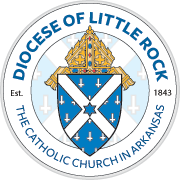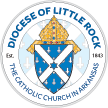
Catholic Advent Traditions
Official Website of the
Catholic Diocese of Little Rock
What's New
Add St. Nicholas Day to Advent traditions - Dec 2, 2025 Advent is full of traditions that can make this wonderful season of anticipation... |
Calendar of Events
| Dec. 13 2025 Immaculate Conception Holiday Market in Fort Smith Immaculate Conception Church - Fort Smith |
| Dec. 16 - Dec. 24 Las Posadas at St. Edward in Little Rock St. Edward Church - Little Rock |
| Dec. 16 - Dec. 24 Las Posadas at Good Counsel in Little Rock Our Lady of Good Counsel Church - Little Rock |
| Dec. 25 Nativity of the Lord (Christmas Day) Diocesan Offices Closed — Holy Day of Obligation |
| Dec. 25, 2026 Nativity of the Lord (Christmas Day) Diocesan Offices Closed — Holy Day of Obligation |
Advent traditions teach as well as entertain
Updated Dec. 13, 2024
There are many Advent traditions to consider when deciding how to deepen your family's experience of the Advent season. The Advent Wreath, Advent Calendar, Jesse Tree, St. Nicholas Day, Our Lady of Guadalupe celebrations, St. Lucy Cakes, Las Posadas, the Nativity Scene, O Antiphons and Festival of Lessons and Carols are among the most popular. Contact your parish to learn about these activities in your area. | Customs Around World
If looking for an overview of these traditions specific to young children, consider these resources: Advent Crafts for Catholic Kids; Advent Crafts to Teach Your Children the Faith; Advent and Christmas Crafts and Activities for Kids; Advent and Christmas Ideas for Kids on Pinterest; or Advent Lesson Plans for Grades 1-8. Visit Simply Catholic to learn about the origins of these traditions. Or discover new ones to try from Busted Halo.
Advent Wreath
The traditional Advent wreath consists of a circle of evergreen branches into which four candles are inserted, signifying the four weeks of Advent. Three of these candles are purple and one is rose.
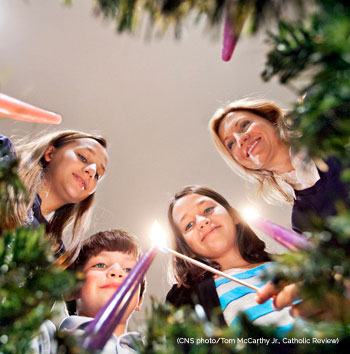 The purple represents prayer, penance and sacrificial good works done in preparation for the coming of the Lord. These candles are lit on the first, second and fourth Sundays of Advent.
The purple represents prayer, penance and sacrificial good works done in preparation for the coming of the Lord. These candles are lit on the first, second and fourth Sundays of Advent.
The rose candle is lit on the third Sunday of Advent, also known as Gaudete Sunday. "Gaudete" is Latin for "rejoice," which is the first word of the entrance antiphon. The celebrant wears rose vestments to signify the anticipatory joy that the waiting is half over and Christmas is near.
The blessing of the wreath takes place on the first Sunday of Advent. While a priest offers this prayer at church, a parent or other family member may extend this blessing at home. Throughout the season, as the candles are progressively lit, participants offer prayers, sing songs, reflect and prepare for the coming of the Lord.
Advent Calendar
Traditionally, an Advent calendar offers daily Scriptures, activities and prayer suggestions to help you spiritually prepare for the birth of Jesus. It begins with the first Sunday of Advent and ends with Christmas.
 The content of an Advent calendar may vary depending on the need of the person, family or group to include personal goals, treats for kids or acts of service so long as the purpose is the same. | 2025 Share Your Light Advent Calendar
The content of an Advent calendar may vary depending on the need of the person, family or group to include personal goals, treats for kids or acts of service so long as the purpose is the same. | 2025 Share Your Light Advent Calendar
There are several ready-made calendars online. You can also develop your own for your home or classroom. These calendars have become popular in recent years, so finding one in the store you can personalize is fairly easy to do. Or you can make one from scratch.
This could be a fun family arts and crafts project. Go to our Advent calendar resource list to find instructions for making an Advent calendar as well as suggestions for activities.
Jesse Tree
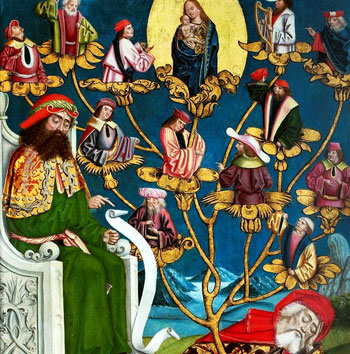 The Jesse Tree introduces Jesus' ancestors and shows how Jesus is descended from King David, uniting the Old Testament with the New Testament. The name comes from Isaiah 11:1: "A shoot shall come out of the stock of Jesse, and a branch shall grow out of his roots." Jesse was the father of King David. | See Genealogy of Jesus.
The Jesse Tree introduces Jesus' ancestors and shows how Jesus is descended from King David, uniting the Old Testament with the New Testament. The name comes from Isaiah 11:1: "A shoot shall come out of the stock of Jesse, and a branch shall grow out of his roots." Jesse was the father of King David. | See Genealogy of Jesus.
Ornaments that illustrate the events leading up to Christ's birth adorn the Jesse Tree, connecting this Advent custom with decorating a Christmas tree. Learn more by reading Arkansas Catholic. The Diocese of Erie, Pennsylvania makes its Jesse Tree ornaments available for free to download here. They are also offer Advent reflections to go with them.
Here are other resources you might enjoy as well: The Jesse Tree for Families; Making a Jesse Tree; Jesse Tree Ornaments and Scriptures; Meaning of Jesse Tree Symbols; Reflections for each week of Advent; and The branches of Jesus’ family tree (download ornaments)
St. Nicholas Day
St. Nicholas was a fourth-century bishop of Myra, a city in Lycia, a province of Asia Minor. He is known for his generosity to the poor. His feast day is celebrated on Dec. 6. The most common tradition for families involves shoes.
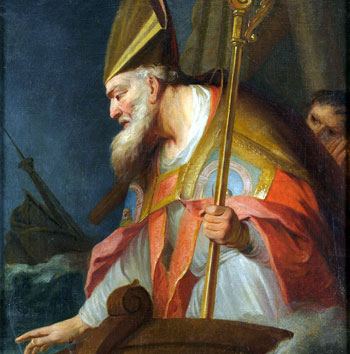 Family members leave their shoes outside their bedroom doors or on the fireplace hearth leaving a carrot for St. Nicholas' horse to eat on St. Nicholas Eve. Sometime during the night, St. Nicholas visits and leaves gifts in the shoes. Any gift can be given, but traditional gifts include gold coins or a candy cane to represent St. Nicholas' crozier (staff carried by bishops to represent their role as shepherd).
Family members leave their shoes outside their bedroom doors or on the fireplace hearth leaving a carrot for St. Nicholas' horse to eat on St. Nicholas Eve. Sometime during the night, St. Nicholas visits and leaves gifts in the shoes. Any gift can be given, but traditional gifts include gold coins or a candy cane to represent St. Nicholas' crozier (staff carried by bishops to represent their role as shepherd).
Another way to celebrate this feast day is to follow St. Nicholas' example and give to the poor anonymously. Catholic Charities of Arkansas offers you a great way to do this by becoming a St. Nicholas Partner.
For more information about the real St. Nicholas or see more ideas for celebrating, visit the following resources: Five Ways to Celebrate the Feast of St. Nicholas; Saint Nicholas: Fact or Fiction?; Legends of St. Nicholas; St. Nicholas for Young Children; Ways to Celebrate St. Nicholas Day with Children; Meet St. Nicholas! Saints for Kids; and The Real St. Nicholas.
Advent Saints
Several traditions developed around the feast days of Advent saints, most notably the St. Andrew Christmas Novena, St. Nicholas Day, Our Lady of Guadalupe processions and St. Lucy caroling and Lucy cakes.
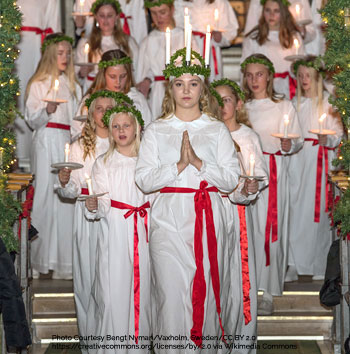 The St. Andrew Christmas Novena is more than 100 years old. Though its origins are unknown, it is believed to have come from Ireland. Tradition holds that whoever prays this prayer 15 times each day from Nov. 30 to Dec. 24 will obtain the favor requested.
The St. Andrew Christmas Novena is more than 100 years old. Though its origins are unknown, it is believed to have come from Ireland. Tradition holds that whoever prays this prayer 15 times each day from Nov. 30 to Dec. 24 will obtain the favor requested.
For St. Nicholas Day, kids leave their shoes outside their bedroom door or on the fireplace hearth on the night of Dec. 5 along with a plate of carrots for St. Nicholas' horse. And sometime during the night, St. Nicholas will visit and leave gifts in your shoes.
A typical way a parish celebrates the feast of Our Lady of Guadalupe is with "mañanitas" (morning songs), a procession, rosary, danzantes, and Mass, followed by a reenactment of the apparitions. Pan dulce, tamales and hot cocoa or hot fruit punch are usually served during the festivities.
St. Lucy's feast is a major celebration in Sweden where young girls go caroling in white robes with red sashes and wreaths of lit candles on their heads to represent St. Lucy's purity, martyrdom and the light of Christ. Also popular is to bake sweets including “Lussekatter" ("St. Lucy Cake") or saffron buns shaped into various shapes.
Las Posadas
Las Posadas, which means "the inns," is an Advent custom celebrated in Mexico, Guatemala, El Salvador and other Latin American countries. It begins on Dec. 16 and continues through Christmas Eve. This novena is a reenactment of Mary and Joseph's search for lodging as they traveled from Nazareth to Bethlehem.
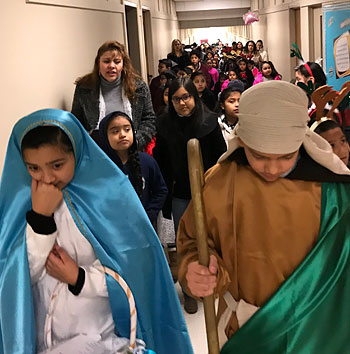 Traditionally, people gather in two groups, an outside group and an inside group. The outside group goes to the door of a house and someone knocks at the door. Together, the group sings traditional Advent and Christmas carols or villancicos asking for shelter. Those inside respond in song, denying shelter, saying there is no room at the inn or posada.
Traditionally, people gather in two groups, an outside group and an inside group. The outside group goes to the door of a house and someone knocks at the door. Together, the group sings traditional Advent and Christmas carols or villancicos asking for shelter. Those inside respond in song, denying shelter, saying there is no room at the inn or posada.
The outside group does this three times. On the third time, the group finally gains entrance. As the group walks in, both groups sing a song in Spanish about holy pilgrims or travelers. The group prays the rosary, followed by a little fiesta, which might include hot chocolate, cookies and perhaps even a piñata for the children.
Sometimes, the last posada is held at the parish and the pilgrims enter as part of the processional for midnight Mass. Learn more about this tradition. Contact your parish or school to find out if this custom will be held in your area. Or consider doing a modified version of this tradition at home.
Nativity Scene
St. Francis of Assisi set up the first Nativity Scene on Christmas Eve in 1223. He invited villagers and friars from Greccio, Italy, to gather for Mass at his manger. He set it up in a cave with live animals and feeding trough converted into a crib. He said, “I want to do something that will recall the memory of that child who was born in Bethlehem, to see with bodily eyes the inconveniences of his infancy, how he lay in the manger, and how the ox and ass stood by.”
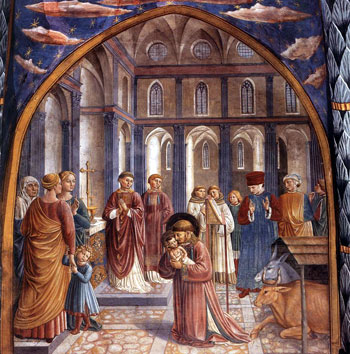 The tradition grew and people began constructing nativity scenes in their homes. A nativity scene or crèche may be made from various materials. Many set up their entire scene at the beginning of Advent, leaving the crib empty for the Christ child to arrive on Christmas Eve. Others set it up slowly, day by day. Mary and Joseph can also "travel" to Bethlehem, as they move slowly across the room each day until they reach the manger.
The tradition grew and people began constructing nativity scenes in their homes. A nativity scene or crèche may be made from various materials. Many set up their entire scene at the beginning of Advent, leaving the crib empty for the Christ child to arrive on Christmas Eve. Others set it up slowly, day by day. Mary and Joseph can also "travel" to Bethlehem, as they move slowly across the room each day until they reach the manger.
In a new apostolic letter, "Admirabile Signum," released Dec. 1, 2019, Pope Francis writes about the meaning and importance of nativity scenes, encouraging us to look at them with fresh eyes. He offers five recommendations on how the Christmas crèche can help us to better appreciate the gift of the Incarnation this Advent.
Learn more from the following resources: Christmas crèche arouses awe and wonder; Saint Francis and the Crib; Advent & Christmas Traditions: The Nativity Scene; and At Home Nativity Play from Luke 2:1-20 and Matthew 2:1-12.
Advent Prayers and Hymns
The O Antiphons are an ancient tradition that refers to the seven antiphons that are recited/chanted before the Magnificat (Canticle of Mary) in the Evening Prayer of the Liturgy of the Hours.
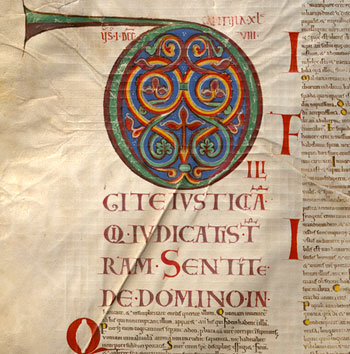 They cover the special time of Advent known as the Octave before Christmas, Dec. 17-23, with Dec. 24 being Christmas Eve and Vespers for that evening being for the Christmas Vigil. The Roman Church has had this tradition since at least the eighth century.
They cover the special time of Advent known as the Octave before Christmas, Dec. 17-23, with Dec. 24 being Christmas Eve and Vespers for that evening being for the Christmas Vigil. The Roman Church has had this tradition since at least the eighth century.
The Festival of Lessons and Carols is a liturgy with Scripture and song that dates back to the 19th century. It includes nine Scripture lessons that recount the fall of man, the promise of a Messiah, incarnation and the great commission to preach the Good News.
Each lesson is followed by a carol or other song that reflects the lesson's message along with a brief prayer. Traditionally, the Cathedral of St. Andrew in Little Rock offers this service, which includes several choral pieces and congregational hymns and prayers. Contact the parish directly for details. Subiaco Academy often hosts this event as well. Contact the school for date and time.
What's New
Add St. Nicholas Day to Advent traditions - Dec 2, 2025 Advent is full of traditions that can make this wonderful season of anticipation... |
Calendar of Events
| Dec. 13 2025 Immaculate Conception Holiday Market in Fort Smith Immaculate Conception Church - Fort Smith |
| Dec. 16 - Dec. 24 Las Posadas at St. Edward in Little Rock St. Edward Church - Little Rock |
| Dec. 16 - Dec. 24 Las Posadas at Good Counsel in Little Rock Our Lady of Good Counsel Church - Little Rock |
| Dec. 25 Nativity of the Lord (Christmas Day) Diocesan Offices Closed — Holy Day of Obligation |
| Dec. 25, 2026 Nativity of the Lord (Christmas Day) Diocesan Offices Closed — Holy Day of Obligation |
